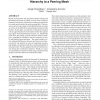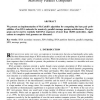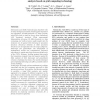282 search results - page 24 / 57 » On predicting secondary structure transition |
CONEXT
2010
ACM
13 years 6 months ago
2010
ACM
Recent measurements and anecdotal evidence indicate that the Internet ecosystem is rapidly evolving from a multi-tier hierarchy built mostly with transit (customer-provider) links...
JCB
2000
13 years 8 months ago
2000
We present an implementation of McCaskill's algorithm for computing the base pair probabilities of an RNA molecule for massively parallel message passing architectures. The p...
IPPS
2007
IEEE
14 years 3 months ago
2007
IEEE
Ribonucleic acid (RNA) molecules play important roles in many biological processes including gene expression and regulation. An RNA molecule is a linear polymer which folds back o...
ISMB
1993
13 years 10 months ago
1993
Weintroduce a parallel approach, "DT-SELECT," for selecting features used by inductive learning algorithms to predict protein secondary structure. DT-SELECTis able to ra...
BMCBI
2004
13 years 8 months ago
2004
Background: Because loops connect regular secondary structures, analysis of the former depends directly on the definition of the latter. The numerous assignment methods, however, ...



